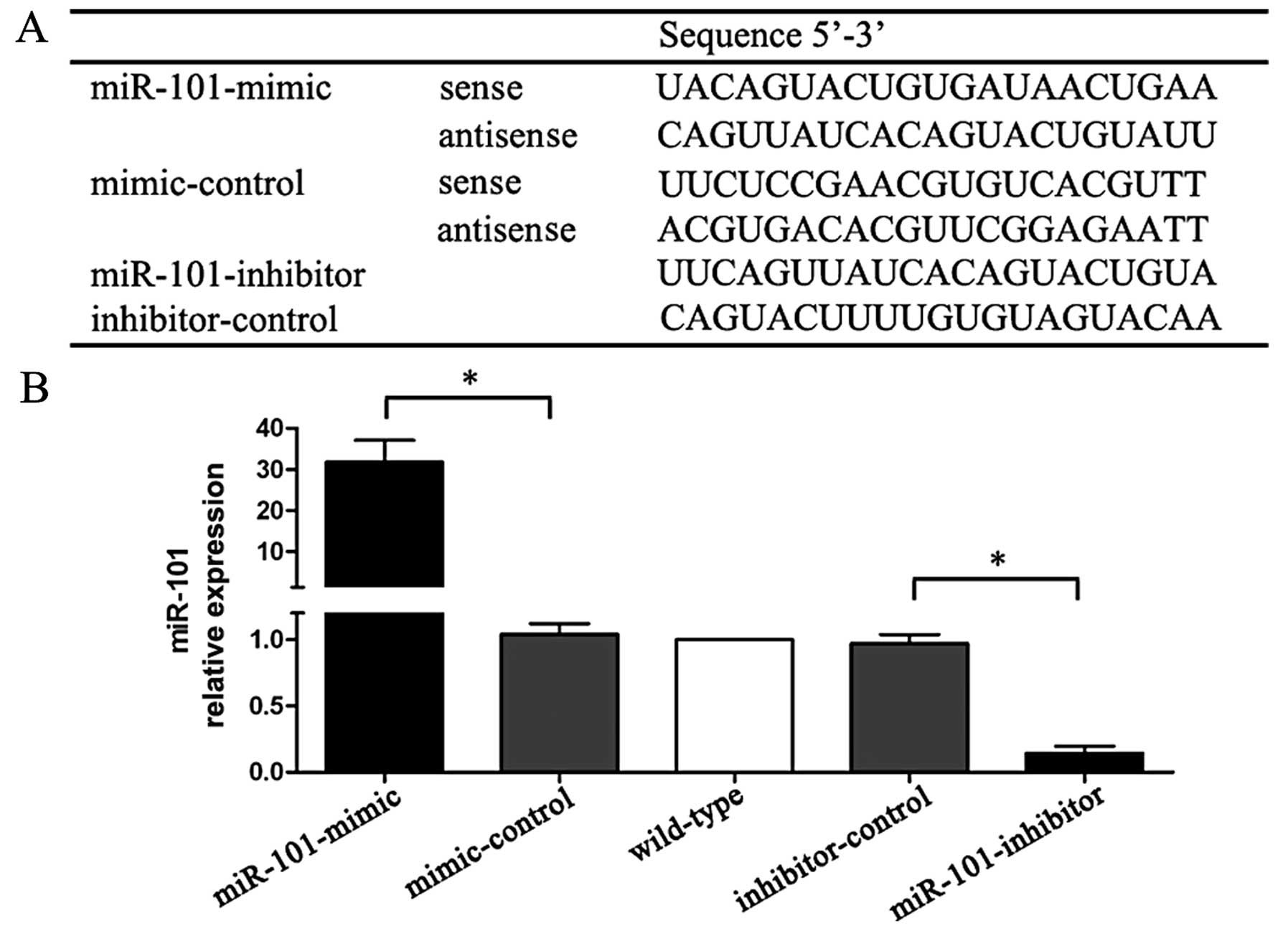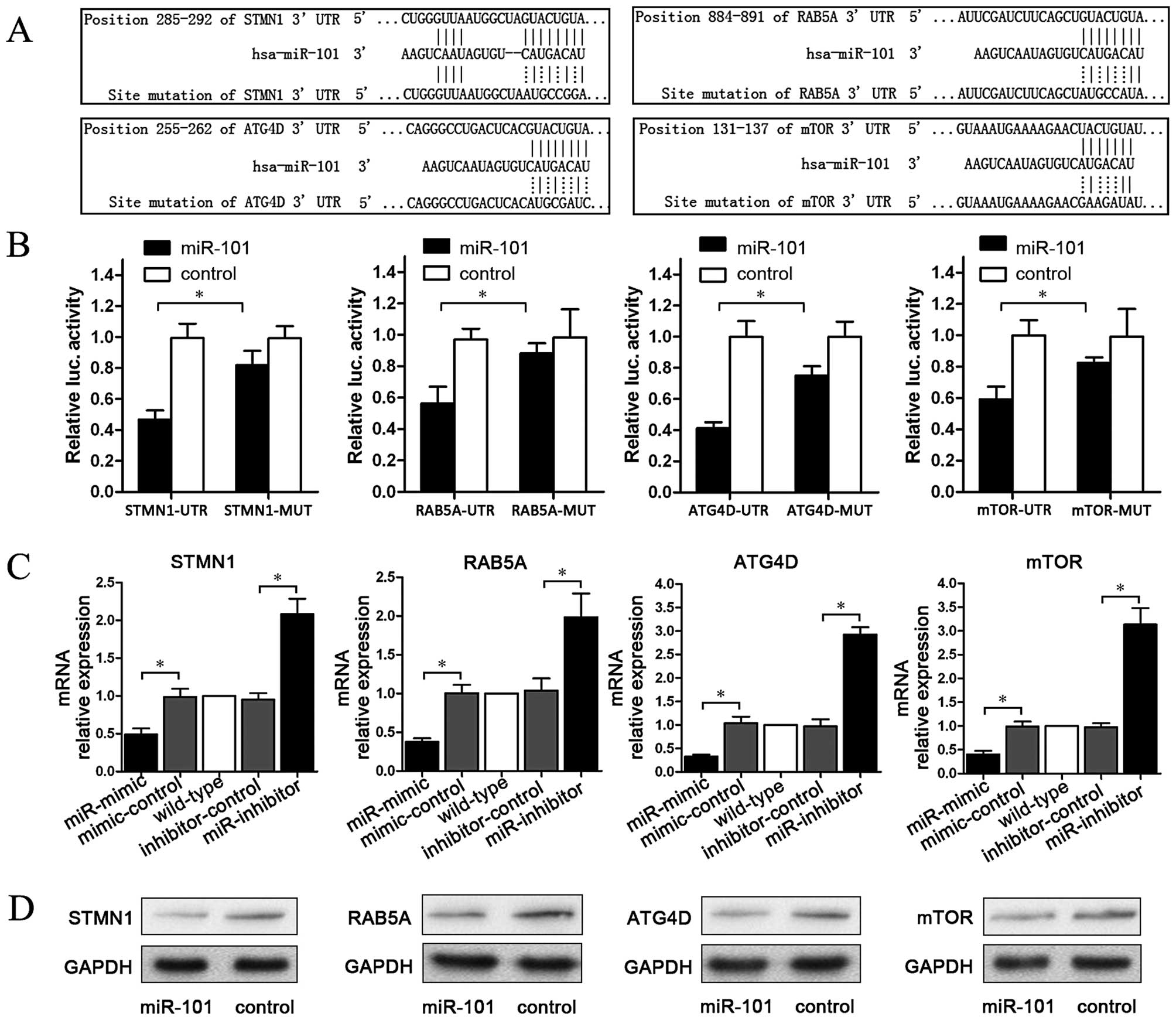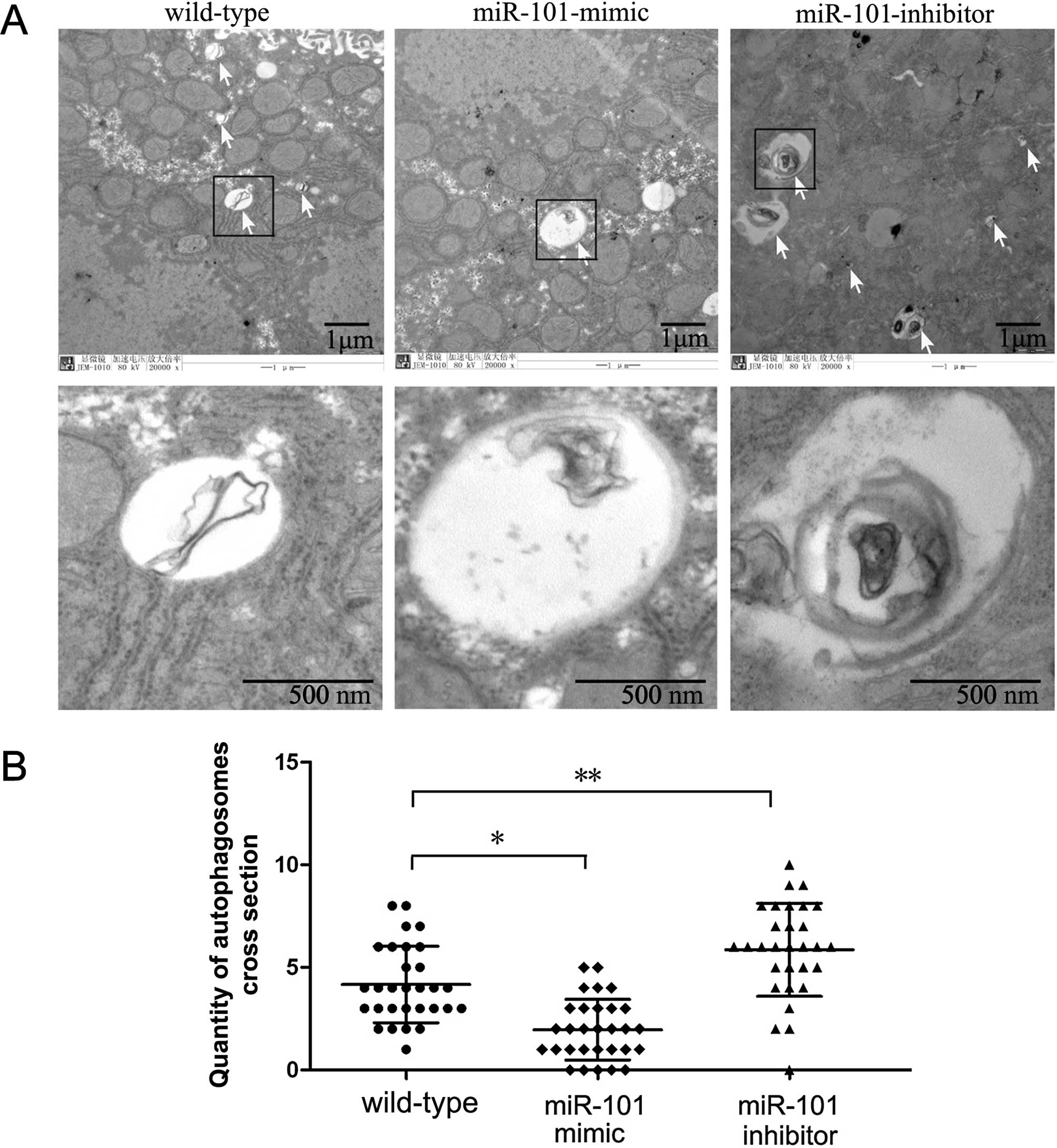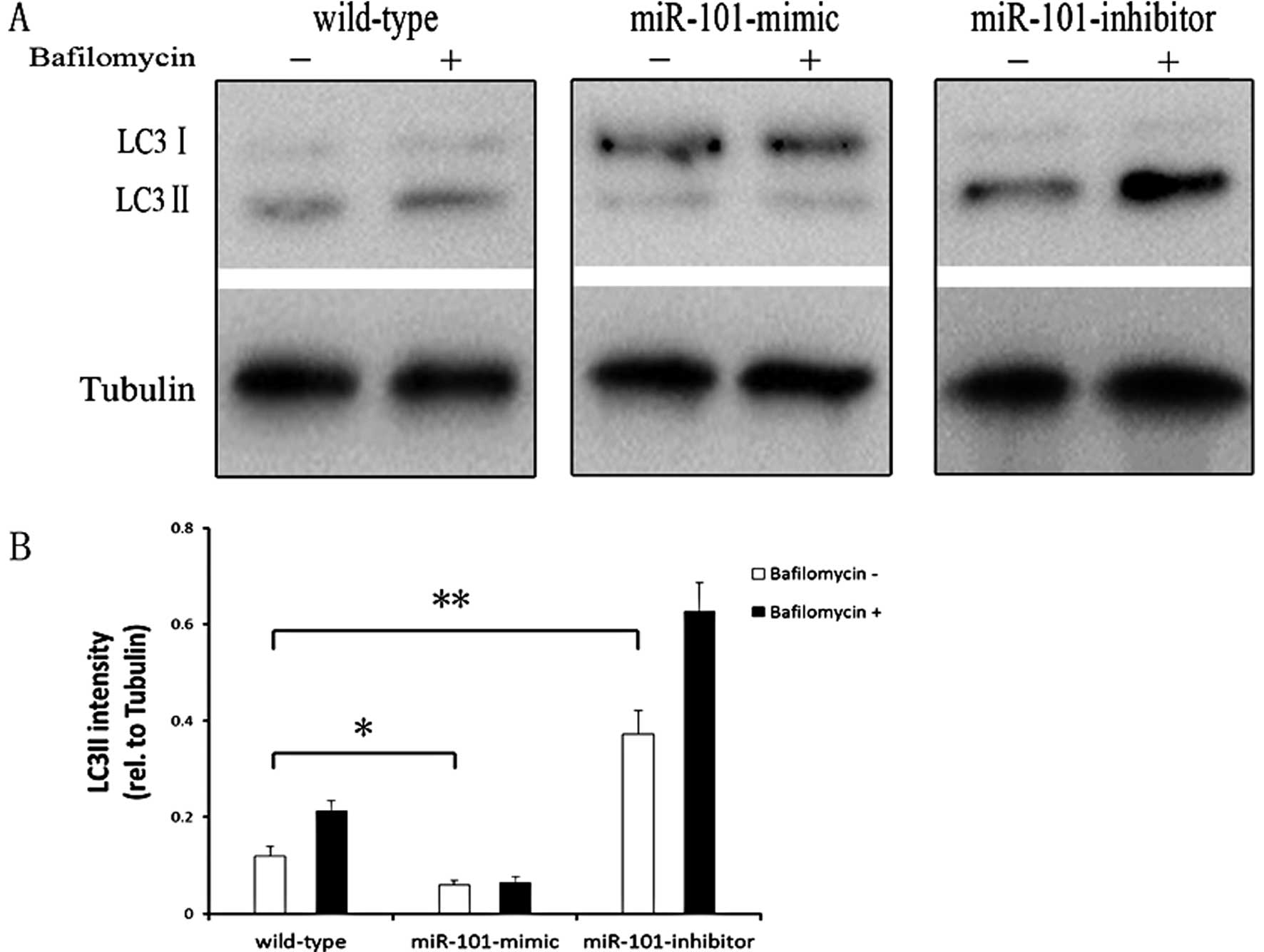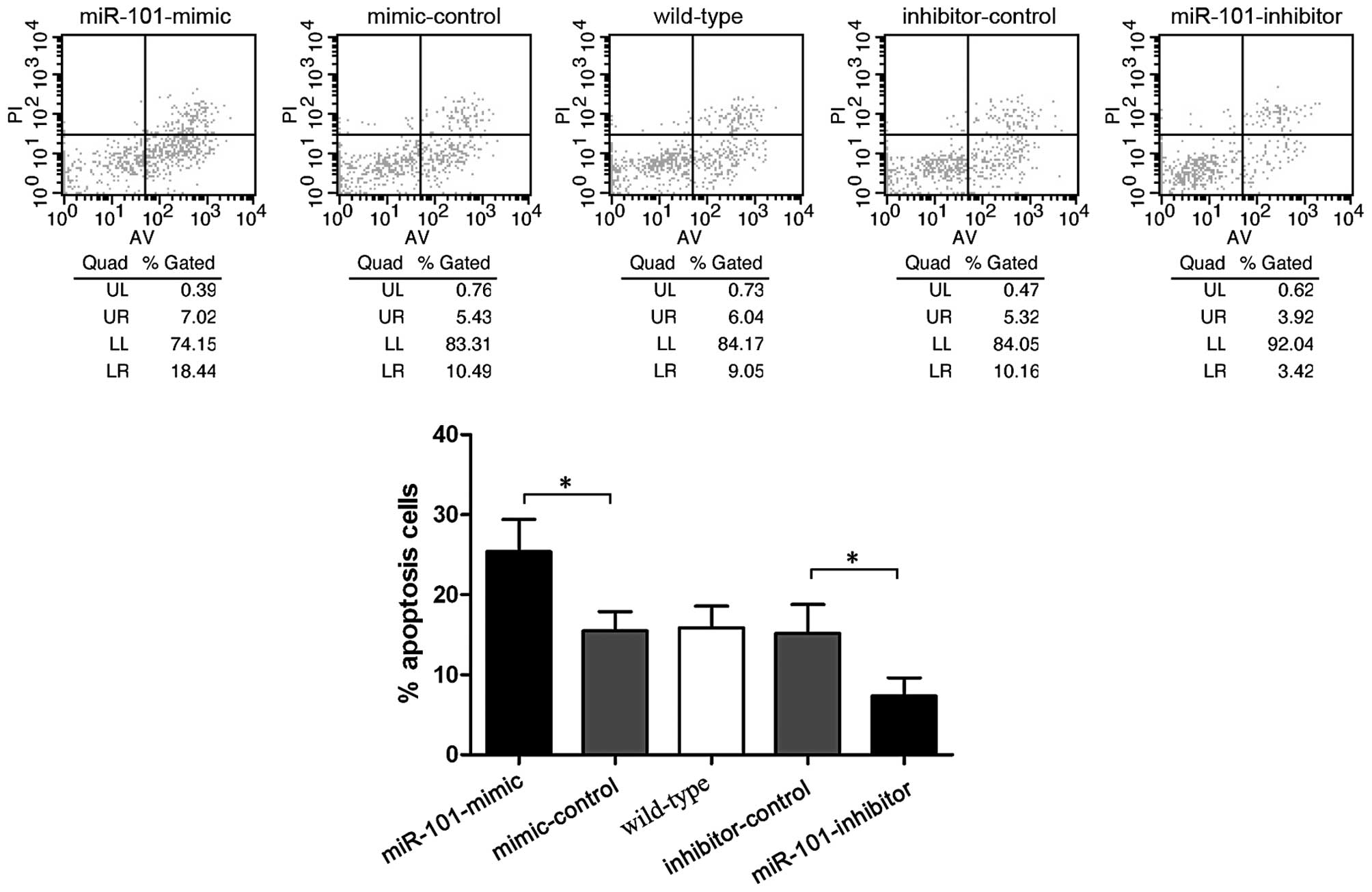miR-101 inhibits autophagy and enhances cisplatin-induced apoptosis in hepatocellular carcinoma cells
- Authors:
- Published online on: March 7, 2013 https://doi.org/10.3892/or.2013.2338
- Pages: 2019-2024
Abstract
Introduction
Hepatocellular carcinoma (HCC) ranks third in cancer-related mortality due to late diagnosis and poor treatment options. To date, the therapies of liver cancer include surgery, chemical therapy and target therapy, but there is no complete treatment (1). An alternative therapy for liver cancer is urgently required.
Autophagy was reported for the first time by Ashford and Porter 50 years ago (2) and it has recently gained considerable attention. Autophagy is a lysosome-mediated protein and organelle degradation process that is characterized by the formation of double-membrane vesicles, referred to as autophagosomes (3,4). Autophagy is involved in several pathophysiological processes and contributes to numerous diseases, particularly to cancer (5,6). However, the function of autophagy in cancer has yet to be fully clarified, as it acts both as a tumor suppressor and as a tumor promoter (7).
Reduced autophagy is associated with a malignant phenotype and poor prognosis of HCC and activation of autophagy contributes to the growth inhibition and cell death in human liver cancer cells (8,9). Increasing evidence shows that autophagy functions as a survival mechanism in liver cancer cells against drug-induced apoptosis. Autophagy inhibition enhances apoptosis induced by ginsenoside Rk1 (10), 3-bromopyruvate (11), BO-1051 (12), etoposide (13) in HCC cell lines. Targeting the autophagy pathway is a promising therapeutic strategy to improve chemotherapy efficiency. Thus, autophagy may play a dual and apparently contradictory role in HCC and the exhibited function may likely depend on the genetic composition of the cell and environmental cues the cell is exposed to.
A number of studies have recently focused on the regulation mechanism of autophagy. For example, TGF-β signaling pathway (14) and IFN-γ (8) activate autophagy in HCC cells. STMN1 (Stathmin 1) (15), RAB GTPase 5A (RAB5A) (16), autophagy-related protein 4D (ATG4D) and mTOR (17) have been reported to play an important role in autophagosome formation. micro-RNAs (miRNAs), which play crucial roles in HCC development and therapy, have been linked to autophagy. miR-375 inhibits autophagy by targeting autophagy-associated gene 7 (ATG7) and impairs the viability of HCC cells under hypoxic conditions both in vivo and in vitro(18). Downregulated miR-199a-5p enhanced autophagy activation by targeting ATG7 in HCC cells (19). It is reported that miR-101 inhibits basal, etoposide- and rapamycin-induced autophagy which can sensitize breast cancer cells to 4-hydroxytamoxifen (4-OHT)-mediated cell death. The targets of miR-101 in this process are STMN1, RAB5A and ATG4D (15). miR-101 sensitized HCC cell lines to chemotherapeutic drug-induced apoptosis by targeting Mcl-1 (20). However, the regulation mechanism of miR-101 and its function on autophagy in HCC remains unclear.
In this study, we report that miR-101 inhibits autophagy and enhances apoptosis induced by cisplatin in HCC cells. The targets of miR-101 are STMN1, RAB5A, ATG4D and mTOR. This study revealed that miR-101 which, inhibits autophagy, might be developed as a potential novel therapy for HCC.
Materials and methods
Cell cultures
Human HCC cell line HepG2 was purchased from Shanghai Cell Bank (Shanghai, China) and propagated in our laboratory by culturing in Dulbecco’s modified Eagle’s medium (DMEM) (Invitrogen, Carlsbad, CA, USA) with 10% fetal bovine serum (FBS) (Sigma, St. Louis, MO, USA), at 37°C with 5% CO2, supplemented with 1% penicillin/streptomycin. Drug treatment included cisplatin (0.25 mg/ml, Sigma) and bafilomycin (400 nM, Sigma) for the indicated times.
miRNA transfection
miRNA transfection was performed using Lipofectamine 2000 (Invitrogen). Total RNA and protein were extracted at 24 h post-transfection and were used for quantitative real-time PCR (qRT-PCR) and western blot analysis. miR-101-mimic, inhibitor and negative control groups were designed and synthesized by GenePharma (Shanghai, China).
Reverse transcription quantitative real-time polymerase chain reaction (RT-qPCR) for miRNA and mRNA quantitation
Total RNA of cells and tissues was isolated using TRIzol reagent (Invitrogen). For miRNA quantitation, cDNA was synthesized with specific miRNA reverse transcriptase primers (Applied Biosystems) using the TaqMan MicroRNA Reverse Transcription kit (Applied Biosystems, Life Technologies Corp., CA, USA). For mRNA quantitation, cDNA was synthesized using the PrimeScript RT reagent kit (Takara, Dalian, China). Quantitative RT-PCR was performed using an ABI 7500 (Applied Biosystems) with FastStart Universal SYBR Green Master (Rox) (Roche, USA) for mRNA quantitation and with TaqMan® MicroRNA Assay kit (Applied Biosystems). The relative expression of miRNA and mRNA were calculated as the inverse log of the ΔΔCT (21) and normalized to U6 and β-actin. Probes for miRNA qPCR were purchased from Applied Biosystems, primers for mRNA qPCR were synthesized by Invitrogen (Shanghai, China); the sequences were: STMN1 sense: 5′-TCTGTCCCAATCTTACCA-3′, antisense: 5′-GAGGCATCCAAACAAAGC-3′; RAB5A sense: 5′-GCTGGTCAAGAACGATAC-3′, antisense: 5′-CTTGCTTGCCTCTGAAGT-3′; ATG4D sense: 5′-GCTGCCTGACCTCGGACTGT-3′, antisense: 5′-TCTGCCCAAGCTCCACCAG-3′; mTOR sense: 5′-CGCTGTCATCCCTTTATCG-3′, antisense: 5′-ATGCTCAAACACCTCCACC-3′; β-actin sense: TCACCCACACTGTGCCCATCTACGA, antisense: CAGCGGAACCGCTCATTGCCAATGG.
Cell apoptosis analysis
Cell apoptosis was assessed by flow cytometry (Becton-Dickinson, San Jose, CA, USA). For cell apoptosis, cells were treated with cisplatin at a final concentration of 10 μM for 48 h. Then, cells were collected, washed, suspended in 100 μl 1X binding buffer, stained with 5 μl fluorescein isothiocyanate (FITC)-Annexin V and 1 μl PI at room temperature for 15 min in the dark. The stained cells were immediately analyzed by flow cytometry.
Luciferase reporter assay
Luciferase reporter constructs were made by ligating 60-bp-long synthetic oligonucleotides (Invitrogen, Shanghai, China) containing putative miRNA binding sites from the 3′-UTR or their mutant versions of STMN1, RAB5A, ATG4D and mTOR in XbaI-FseI sites of the pGL3-control vector (Promega). Cloning was verified by sequencing. HepG2 cells were plated at 1.5×105 cells/well in 24-well plates 24 h prior to transfection. Each independent luciferase reporter plasmid (200 ng) plus 80 ng pRL-TK (Promega) was transfected in combination with 60 pmol of miR-101-mimic, inhibitor and controls using Lipofectamine 2000 (Invitrogen). Luciferase activity was measured 48 h after transfection by using the Dual-Luciferase Reporter assay system (Promega). Firefly luciferase activity was normalized to Renilla luciferase activity for each transfected well.
Western blotting
Cells were lysed using RIPA buffer with 1% PMSF on ice. The concentration of total protein was determined using a BCA kit (Keygen, Nanjing, China). Equal amounts of protein (30 μg) were resolved with 10% SDS-PAGE and transferred to polyvinylidene difluoride (PVDF) membranes (Millipore, Bedford, MA, USA) using a mini trans-blot apparatus (Bio-Rad Laboratories, Hercules, CA, USA). Membranes were probed with primary antibodies for 12 h at 4°C and then incubated with secondary antibodies for 2 h at room temperature. The primary antibodies used were: microtubule-associated protein light chain 3 (LC3) and RAB5A rabbit polyclonal antibodies (Novus Biologicals, Littleton, CO, USA), STMN1 and mTOR antibodies (Cell Signaling Technology, Danvers, MA, USA). ATG4D antibody (Abgent, San Diego, CA, USA). GAPDH and tubulin (Santa Cruz Biotechnology, Santa Cruz, CA, USA) were used as an internal control. The secondary antibody was purchased from Beyotime (Santa Cruz Biotechnology). Electrochemiluminescence was performed with a ChemiImager 5500 imaging system (Alpha Innotech Co., San Leandro, CA, USA).
Transmission electron microscopy
Representative images were taken of cells transfected for 72 h as indicated and treated for 2 h with 200 nM rapamycin prior to fixation. For ultrastructural examination, liver samples ~1 mm3 were fixed with 2% OsO4 and embedded in Araldite. Ultrathin sections were stained with uranyl acetate and lead citrate and inspected using an electron microscope (JEM-1010; Jeol, Tokyo, Japan).
Statistical analysis
All experiments were repeated in triplicate. All values were the means ± standard deviation (SD). Statistical significance was determined with a Student’s t-test using SPSS 15.0. P-values <0.05 were considered to indicate statistically significant differences.
Results
Verification of miR-101 transfection
The sequences of miR-mimic, miR-inhibitor and controls are listed in Fig. 1A. The expression levels of miR-101 were confirmed by qRT-PCR. miR-mimic-treated cells showed a 31-fold higher miR-101 expression than mimic-control treated cells, whereas miR-inhibitor cells had an 85% lower expression when compared with inhibitor-control treated cells (Fig. 1B).
miR-101 targets STMN1, RAB5A, ATG4D and mTOR
To explore the regulation mechanism of miR-101, we predicted four target genes (STMN1, RAB5A, ATG4D and mTOR) which were matched with miR-101 on the website www.targetscan.org. Then, plasmids containing matching or mutant sequences of each gene were constructed. These sequences are listed in Fig. 2A. To establish a direct molecular link between miR-101 and target genes, luciferase reporter assay was performed. The data showed that compared to the control group, miR-101 significantly reduced the activity of the STMN1, RAB5A, ATG4D and mTOR 3′-UTR luciferase plasmids, whereas plasmids containing mutant sequences were not significantly affected (P<0.05; Fig. 2B). To examine the effect of miR-101 on endogenous mRNAs of STMN1, RAB5A, ATG4D and mTOR, qPCR was carried out to detect mRNA changes in miR-101-mimic transfected cells. The results showed that compared with the control group, miR-101-mimic significantly reduced STMN1, RAB5A, ATG4D and mTOR mRNA levels, whereas miR-101-inhibitor elevated the mRNA levels of these four genes (P<0.05; Fig. 2C). Finally, we tested the effect of miR-101 on the protein of STMN1, RAB5A, ATG4D and mTOR. As shown in Fig. 2D, miR-101 downregulated STMN1, RAB5A, ATG4D and mTOR protein. Therefore, miR-101 targets STMN1, RAB5A, ATG4D and mTOR, downregulating them both at the mRNA and at the protein level.
miR-101 suppresses autophagy
Since the formation of special double-membraned structures containing undigested cytoplasmic contents (autophagosomes) is the most important characteristic of autophagy, demonstrating these structures by electron microscopy is considered the gold standard for documenting autophagy. Hence, we examined the ultrastructural changes in HepG2 cells undergoing miR-101-mimic/inhibitor treatment. Prior to fixation, cells were transfected with miR-101-mimic or miR-101-inhibitor for 72 h. Non-transfected cells were used as a control. Quantification of autophagosomes per cellular cross-section revealed that autophagosomes were rarely detected in the non-transfected cell group. However, the number of autophagosomes was significant reduced in the miR-101-mimic group (Fig. 3). LC3 is also widely used to monitor autophagy. The density of LC3-II band divided by the density of tubulin band, which represented the expression level of LC3-II. The ratio of LC3-II level/tubulin level was used as an indicator of autophagic level. In our experiment, HepG2 cells were transfected with miR-101-mimic or miR-101-inhibitor for 72 h. Cells were treated with bafilomycin (400 nM, Sigma), which significantly inhibits autophagy, for 2 h and used as an autophagy inhibitor. Non-transfected cells were used as a control. Western blotting results showed that, compared with the non-transfected group, miR-101-mimic significantly reduced the ratio of LC3-II level/tubulin levels, suggesting the process of autophagy was inhibited. Meanwhile, miR-101-inhibitor elevated the ratio of LC3-II level/tubulin significantly (Fig. 4). Therefore, miR-101 plays the function of inhibition of autophagy.
miR-101 enhances sensitization to cisplatin
In order to investigate the role of miR-101 in chemotherapy, cisplatin induced-apoptosis was assessed by flow cytometry. Following treatment with 10 μM cisplatin for 48 h, miR-101-mimic transfected cells showed a higher apoptosis ratio (25.37±4.05%), whereas miR-101-inhibitor exhibited a lower apoptosis ratio (7.35±2.25%; P<0.05) (Fig. 5). This indicated that miR-101 increases cisplatin sensitivity of HepG2 cells.
Discussion
In this study, we demonstrated that miR-101 enhances apoptosis induced by cisplatin in HCC cells. In addition, our data showed that the targets of miR-101 are STMN1, RAB5A, ATG4D and mTOR. These results suggest that miR-101 plays an important role in the cisplatin-induced apoptosis in HCC cells by inhibiting autophagy.
It is reported that miR-101 is low expressed in different types of cancer (20, 22–24). Emerging evidence suggests that miR-101 induces apoptosis, suppresses tumorigenicity and inhibits migration and invasion of gastric cancer cells (25). miR-101 sensitizes HCC cells to apoptosis and impairs the ability of cancer cells to form colonies both in vitro and in vivo(20). Moreover, myeloid cell leukemia sequence 1 (Mcl-1) was characterized as a direct target of miR-101. In addition, it was demonstrated that the TPA-induced ERK signaling pathway in HepG2 cells upregulates expression of miR-101 (23). In this study, we investigated the role of miR-101 in cisplatin-induced apoptosis of HCC cells. We found that miR-101 enhanced apoptosis induced by cisplatin in HCC cells, indicating the potential application of miR-101 in HCC therapy.
Increasing evidence shows that autophagy functions as a survival mechanism in liver cancer cells against drug-induced apoptosis. A recent study showed that miRNA-101 is a potent inhibitor of autophagy in breast cancer cells. In addition, STMN1, RAB5A and ATG4D were identified as direct targets (26). In our study, miR-101 inhibited autophagy in HCC cells. Aside from STMN1, RAB5A and ATG4D, we found that mTOR was targeted directly by miR-101 as well. It is well known that suppression of mTOR leads to activation of autophagy. It seems controversial that miR-101 suppresses mTOR and inhibits autophagy. It is also well documented that several targets exist for a miRNA. Thus, the role of a miRNA is the result of changes in all of these target genes. It may be that, although we found four targets for miR-101 in autophagy, the exhibited role of miR-101 was mainly based on STMN1, RAB5A and ATG4D protein level change.
In conclusion, we showed that miR-101 plays a key role in enhancing apoptosis induced by cisplatin in HCC cells. The possible mechanism of this effect may be through inhibition of autophagy via targets including RAB5A, STMN1 and ATG4D. We propose that gene therapy targeting miR-101/autophagy should be investigated further as a potential alternative therapeutic strategy for HCC.
Acknowledgements
This study was supported by grants from the Department of Public Health of Jiangsu Province (no. RC2007056) and the National Natural Science Foundation of China (no. 81170415).
References
|
El-Serag HB and Rudolph KL: Hepatocellular carcinoma: epidemiology and molecular carcinogenesis. Gastroenterology. 132:2557–2576. 2007. View Article : Google Scholar : PubMed/NCBI | |
|
Ashford TP and Porter KR: Cytoplasmic components in hepatic cell lysosomes. J Cell Biol. 12:198–202. 1962. View Article : Google Scholar : PubMed/NCBI | |
|
Mizushima N, Levine B, Cuervo AM and Klionsky DJ: Autophagy fights disease through cellular self-digestion. Nature. 451:1069–1075. 2008. View Article : Google Scholar : PubMed/NCBI | |
|
Levine B and Kroemer G: Autophagy in the pathogenesis of disease. Cell. 132:27–42. 2008. View Article : Google Scholar : PubMed/NCBI | |
|
Mathew R, Karantza-Wadsworth V and White E: Role of autophagy in cancer. Nat Rev Cancer. 7:961–967. 2007. View Article : Google Scholar | |
|
Yang ZJ, Chee CE, Huang S and Sinicrope FA: The role of autophagy in cancer: therapeutic implications. Mol Cancer Ther. 10:1533–1541. 2011. View Article : Google Scholar : PubMed/NCBI | |
|
Eskelinen EL: The dual role of autophagy in cancer. Curr Opin Pharmacol. 11:294–300. 2011. View Article : Google Scholar : PubMed/NCBI | |
|
Li P, Du Q, Cao Z, et al: Interferon-gamma induces autophagy with growth inhibition and cell death in human hepatocellular carcinoma (HCC) cells through interferon-regulatory factor-1 (IRF-1). Cancer Lett. 314:213–222. 2012. View Article : Google Scholar | |
|
Ding ZB, Shi YH, Zhou J, et al: Association of autophagy defect with a malignant phenotype and poor prognosis of hepatocellular carcinoma. Cancer Res. 68:9167–9175. 2008. View Article : Google Scholar : PubMed/NCBI | |
|
Ko H, Kim YJ, Park JS, Park JH and Yang HO: Autophagy inhibition enhances apoptosis induced by ginsenoside Rk1 in hepatocellular carcinoma cells. Biosci Biotechnol Biochem. 73:2183–2189. 2009. View Article : Google Scholar : PubMed/NCBI | |
|
Ganapathy-Kanniappan S, Geschwind JF, Kunjithapatham R, et al: 3-Bromopyruvate induces endoplasmic reticulum stress, overcomes autophagy and causes apoptosis in human HCC cell lines. Anticancer Res. 30:923–935. 2010.PubMed/NCBI | |
|
Chen LH, Loong CC, Su TL, et al: Autophagy inhibition enhances apoptosis triggered by BO-1051, an N-mustard derivative and involves the ATM signaling pathway. Biochem Pharmacol. 81:594–605. 2011. View Article : Google Scholar : PubMed/NCBI | |
|
Xie BS, Zhao HC, Yao SK, et al: Autophagy inhibition enhances etoposide-induced cell death in human hepatoma G2 cells. Int J Mol Med. 27:599–606. 2011.PubMed/NCBI | |
|
Kiyono K, Suzuki HI, Matsuyama H, et al: Autophagy is activated by TGF-beta and potentiates TGF-beta-mediated growth inhibition in human hepatocellular carcinoma cells. Cancer Res. 69:8844–8852. 2009. View Article : Google Scholar : PubMed/NCBI | |
|
Frankel LB, Wen J, Lees M, et al: microRNA-101 is a potent inhibitor of autophagy. EMBO J. 30:4628–4641. 2011. View Article : Google Scholar : PubMed/NCBI | |
|
Ravikumar B, Imarisio S, Sarkar S, O’Kane CJ and Rubinsztein DC: Rab5 modulates aggregation and toxicity of mutant huntingtin through macroautophagy in cell and fly models of Huntington disease. J Cell Sci. 121:1649–1660. 2008. View Article : Google Scholar : PubMed/NCBI | |
|
Jung CH, Ro SH, Cao J, Otto NM and Kim DH: mTOR regulation of autophagy. FEBS Lett. 584:1287–1295. 2010. View Article : Google Scholar : PubMed/NCBI | |
|
Chang Y, Yan W, He X, et al: miR-375 inhibits autophagy and reduces viability of hepatocellular carcinoma cells under hypoxic conditions. Gastroenterology. 143:177–187.e8. 2012. View Article : Google Scholar | |
|
Xu N, Zhang J, Shen C, et al: Cisplatin-induced downregulation of miR-199a-5p increases drug resistance by activating autophagy in HCC cell. Biochem Biophys Res Commun. 423:826–831. 2012. View Article : Google Scholar : PubMed/NCBI | |
|
Su H, Yang JR, Xu T, et al: MicroRNA-101, down-regulated in hepatocellular carcinoma, promotes apoptosis and suppresses tumorigenicity. Cancer Res. 69:1135–1142. 2009. View Article : Google Scholar : PubMed/NCBI | |
|
Livak KJ and Schmittgen TD: Analysis of relative gene expression data using real-time quantitative PCR and 2(−Delta Delta C(T)) Method. Methods. 25:402–408. 2001. | |
|
Varambally S, Cao Q, Mani RS, et al: Genomic loss of microRNA-101 leads to overexpression of histone methyltransferase EZH2 in cancer. Science. 322:1695–1699. 2008. View Article : Google Scholar : PubMed/NCBI | |
|
Chiang CW, Huang Y, Leong KW, et al: PKCalpha mediated induction of miR-101 in human hepatoma HepG2 cells. J Biomed Sci. 17:352010. View Article : Google Scholar : PubMed/NCBI | |
|
Buechner J, Tomte E, Haug BH, et al: Tumour-suppressor microRNAs let-7 and mir-101 target the proto-oncogene MYCN and inhibit cell proliferation in MYCN-amplified neuroblastoma. Br J Cancer. 105:296–303. 2011. View Article : Google Scholar : PubMed/NCBI | |
|
Wang HJ, Ruan HJ, He XJ, et al: MicroRNA-101 is down-regulated in gastric cancer and involved in cell migration and invasion. Eur J Cancer. 46:2295–2303. 2010. View Article : Google Scholar : PubMed/NCBI | |
|
Gui T and Shen K: miRNA-101: A potential target for tumor therapy. Cancer Epidemiol. 36:537–540. 2012. View Article : Google Scholar : PubMed/NCBI |



